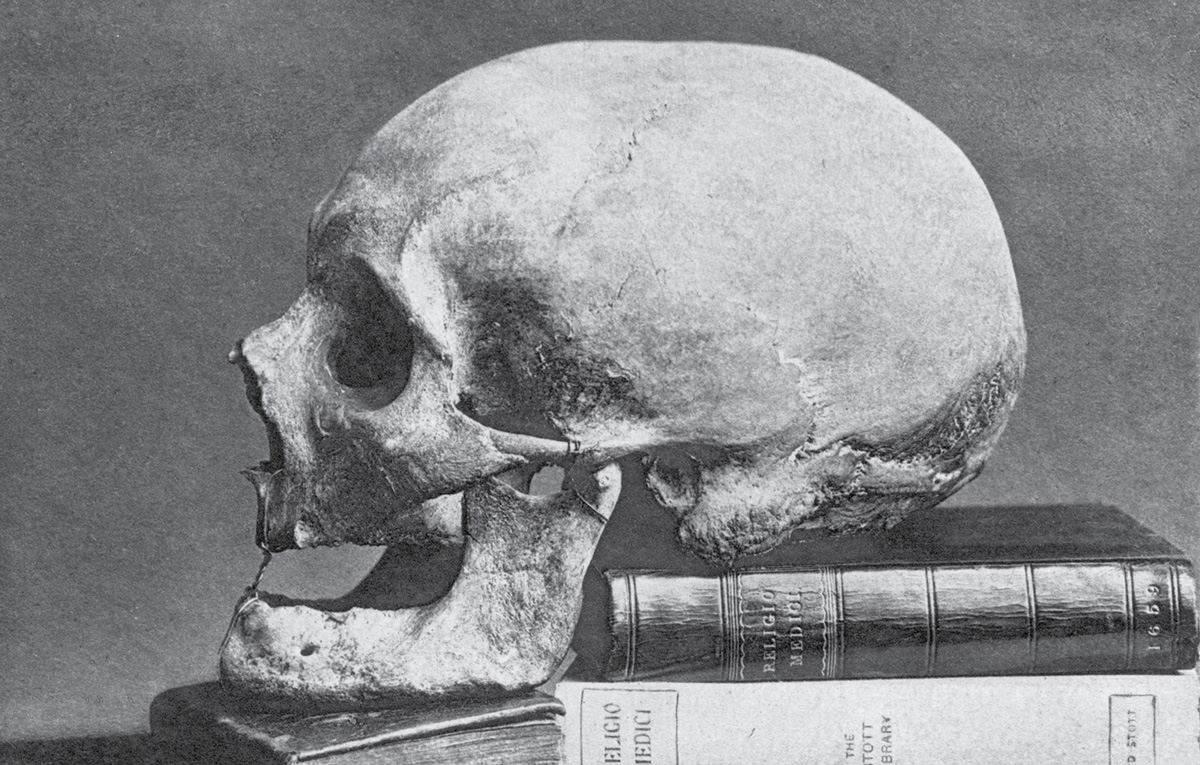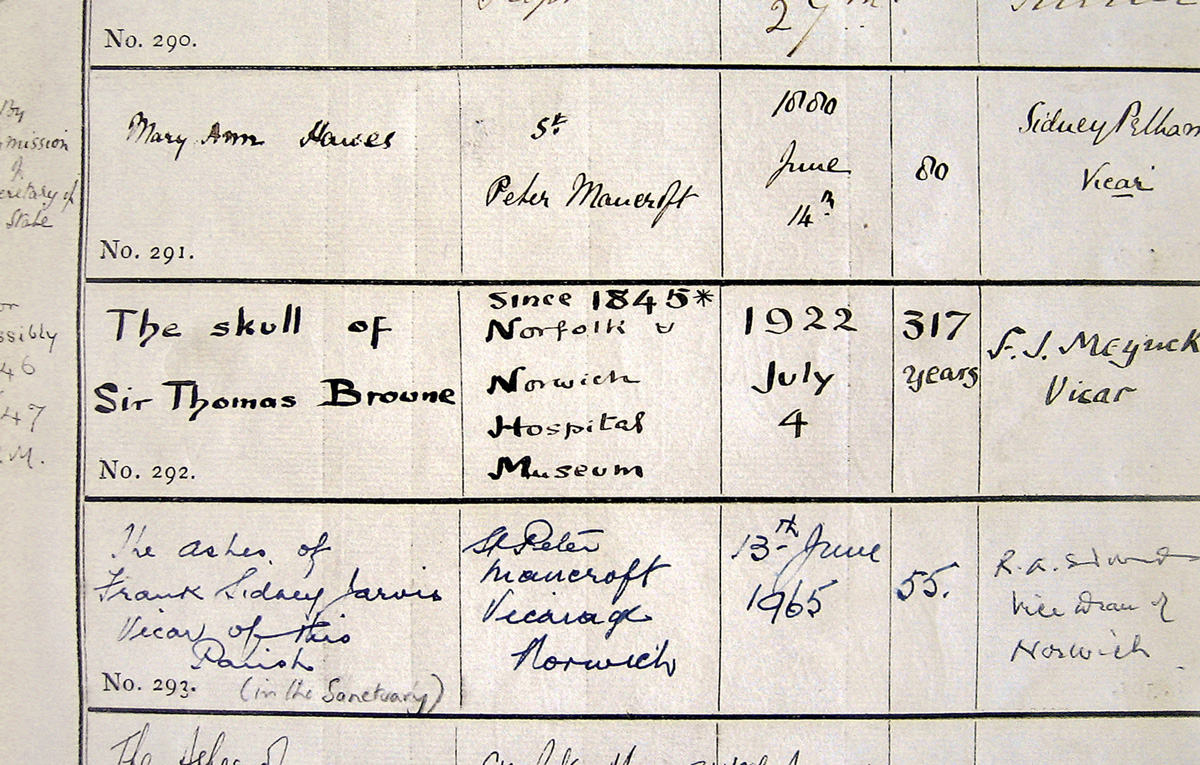The Fate of His Bones
Sir Thomas Browne and the craniokleptic impulse
Colin Dickey
The first half of the nineteenth century was the golden age of a practice that I call “cranioklepty,” or skull-theft. Throughout the nineteenth century, scientists and other interested parties became increasingly cavalier about disturbing the final resting places of famous men, collecting the skulls of the exceptional and the noteworthy[1]. This lust for skulls came in part from the burgeoning science of cranioscopy, originated by Franz-Joseph Gall, and its more well-known offshoot, phrenology, a term coined by Gall’s protégé, Emile Spurzheim. The Enlightenment’s preoccupation with vision as a means to knowledge led to a desire to see how the brain functioned; for Gall and Spurzheim, the skull could act as a recording surface for the brain’s inner workings, mapping its contours and revealing how aspects of personality were imprinted spatially in different areas of the brain. Given that cranioscopy had been born at the University of Vienna (where both Gall and Spurzheim taught), the disinterred skulls of Viennese composers—including Mozart, Haydn, Beethoven, and Schubert—received special attention from phrenologists interested in confirming the existence of the “music bump,” the node on the brain that supposedly corresponded to musical genius.
Viennese composers were not, however, the only ones to suffer this fate. The English doctor and philosopher Sir Thomas Browne (1605—1682) stands as something of an icon in the history of cranioklepty, because of the anxiety he seemed to express about the desecration of his own final resting place. “But who knows the fate of his bones, or how often he is to be buried? Who hath the oracles of his ashes, or whither they are to be scattered?”, Browne wrote in 1658, arguing that “To be gnawed out of our graves, to have our skulls made drinking-bowls, and our bones turned into pipes to delight and sport our enemies, are tragical abominations.”[2] Because of statements like these, Browne might be considered the patron saint of stolen skulls, speaking for the collective indignity of all those whose heads were shuffled between museums, collectors, and anatomists throughout the nineteenth century.


The “tragical abomination” visited upon Browne began in 1840 when his coffin in St. Peter Mancroft Church, Norfolk, was inadvertently disturbed while a vault was being dug next to his plot. Sensing an opportunity, the sexton George Potter absconded with the skull, later selling it to the surgeon Edward Lubbock. When Lubbock died in 1847, he deeded Browne’s skull to the Norfolk and Norwich Hospital Museum, which put it on display. Over the next few decades, the church made repeated entreaties to the museum to have the skull returned, to no avail.
In response to a request in 1893, the hospital’s board, after a “prolonged and careful consideration of all the circumstances which pertained to the request,” refused the vicar’s entreaty by a unanimous vote, citing as their reasons:
That as there is no legal title to, or property in, any such relic, so there can be no question that this and all other specimens in the Hospital Museum belong inalienably to the Governors. That no instance is known of such a claim for restitution having been made after nearly half a century on any museum, and were the Governors to yield to this request they might be unable to resist similar claims. That the presence in a museum of such a relic, reverently preserved and protected, cannot be viewed as merely an object of idle curiosity; rather it will usefully serve to direct attention to, and remind visitors of, the works of the great scholar and physician.[3]
It was not until 1922 that the St. Peter Mancroft Church was finally able to rebury the retrieved skull. At time of Browne’s second interment, the vicar recorded the age of the deceased as “317 years.”
- Instances of cranioklepty continued into the twentieth century—stories persist that Prescott Bush (grandfather of George W. Bush) paid Emil L. Holmdahl $25,000 to steal the skull of Pancho Villa in 1926, after Bush himself had stolen Geronimo’s skull in 1918 (both are supposedly housed in Yale’s Skull and Bones fraternity)—but it is primarily a nineteenth-century phenomenon, when phrenology was at its height.
- Thomas Browne, Religio Medici, Hydriotaphia and The Garden of Cyrus, ed. Robin Robbins (Oxford: Clarendon Press, 1972), pp. 91, 117. For another take on the history of Browne’s skull, see W. G. Sebald’s The Rings of Saturn.
- Quoted in Charles Williams, “The Skull of Sir Thomas Browne,” in Notes and Queries, series 8, vol. 6, pp. 269–270.
Colin Dickey is a writer based in Los Angeles. He is the co-editor (with Nicole Antebi and Robby Herbst) of Failure! Experiments in Social and Aesthetic Practices, and his work has appeared in TriQuarterly, the Santa Monica Review, the Journal of Aesthetics & Protest, and elsewhere.